The global microwave source market is valued at USD 3,006.5 million with growth projected to reach USD 6,673.3 million, creating an absolute increase of USD 3,666.8 million. The expansion reflects total growth of 122% and a CAGR of 8.3%, resulting in the market more than doubling in size at approximately 2.2X. An analysis of historical and forecast growth reveals how the industry transitioned from moderate adoption in earlier years to accelerated expansion during the forecast horizon ending in 2035.
Historically, the market demonstrated steady but less aggressive momentum. In the years leading up to 2025, microwave sources were primarily adopted in niche sectors such as satellite communications, defense radars, and select industrial heating applications. Growth rates during this stage were often moderate, reflecting high costs, limited application diversity, and slower technology penetration across commercial domains. Healthcare applications such as microwave-based diagnostics and treatments were at an early adoption stage, while industrial heating processes remained dominated by conventional technologies. Incremental growth was largely driven by advancements in defense and aerospace, but adoption outside these core areas progressed gradually, resulting in restrained historical CAGR before 2025.
The forecast period presents a stronger trajectory as applications diversify and adoption intensifies. From 2025 to 2030, growth is expected to accelerate, adding significant value as microwave sources gain wider usage in telecommunications and medical equipment. Expansion of 5G and early exploration of 6G infrastructure will create robust demand for high-frequency, reliable microwave systems. In parallel, healthcare will contribute meaningfully through treatments such as microwave ablation and imaging technologies, aligning with rising investments in advanced therapeutic equipment. This early part of the forecast period emphasizes scaling up production and broadening end-user reach, positioning the market firmly on a faster growth curve.
Between 2030 and 2035, momentum remains strong, with the market adding further incremental gains to reach USD 6,673.3 million. This stage reflects a shift from accelerated adoption to sustained maturity, where microwave sources become embedded across telecommunications, aerospace, industrial heating, and healthcare systems as standard solutions. Advanced manufacturing will rely increasingly on precision microwave heating for materials processing, while aerospace and defense will continue upgrading radar and electronic warfare systems. Healthcare growth will be reinforced by higher acceptance of microwave-based therapies, creating stable recurring demand.
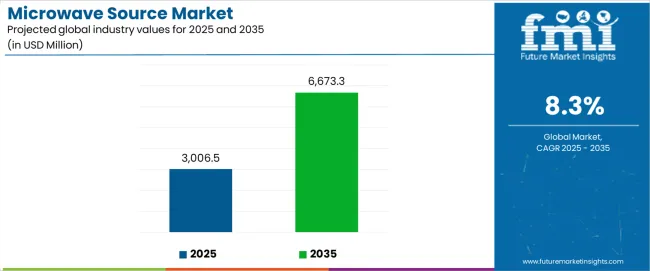
Between 2025 and 2030, the microwave source market is projected to expand from USD 3,006.5 million to USD 4,479.2 million, resulting in a value increase of USD 1,472.7 million, which represents 40.2% of the total forecast growth for the decade. This phase of development will be shaped by increasing demand for precision heating solutions, rising communication infrastructure enabling advanced signal processing techniques, and growing availability of automated microwave systems across medical treatment facilities and industrial processing operations.
Between 2030 and 2035, the microwave source market is forecast to grow from USD 4,479.2 million to USD 6,673.3 million, adding another USD 2,194.1 million, which constitutes 59.8% of the overall ten-year expansion. This period is expected to be characterized by the advancement of solid-state microwave technologies, the integration of IoT connectivity for remote monitoring, and the development of premium frequency control systems across diverse application domains. The growing emphasis on energy efficiency optimization and electromagnetic interference reduction will drive demand for advanced microwave varieties with enhanced power stability characteristics, improved frequency precision capabilities, and superior performance profiles.
Between 2020 and 2024, the microwave source market experienced steady growth, driven by the increasing development of telecommunications infrastructure and the growing recognition of microwave technology's effectiveness in delivering consistent heating and communication solutions across various industrial and medical applications. The microwave source market developed as engineers recognized the potential for advanced microwave sources to deliver operational precision while meeting modern requirements for frequency stability and high-power generation capabilities. Technological advancements in semiconductor technology and solid-state design have begun to emphasize the critical importance of maintaining signal purity while enhancing equipment reliability and improving energy conversion rates.
| Metric | Value |
|---|---|
| Estimated Value in (2025E) | USD 3,006.5 million |
| Forecast Value in (2035F) | USD 6,673.3 million |
| Forecast CAGR (2025 to 2035) | 8.3% |
From 2030 to 2035, the microwave source market is forecast to grow from USD 4,479.2 million to USD 6,673.3 million, adding another USD 2,194.1 million, which constitutes 59.8% of the overall ten-year expansion. This period is expected to be characterized by the advancement of digital frequency control systems, the integration of automated power monitoring systems for operational efficiency, and the development of specialized waveguide configurations for enhanced signal transmission. The growing emphasis on equipment miniaturization and operational precision will drive demand for premium varieties with enhanced thermal stability credentials, improved modulation options, and superior functionality characteristics.
Between 2020 and 2024, the microwave source market experienced robust growth, driven by increasing awareness of microwave heating benefits and growing recognition of communication systems' effectiveness in supporting efficient data transmission operations across telecommunications networks and medical treatment facilities. The microwave source market developed as users recognized the potential for specialized microwave sources to deliver performance advantages while meeting modern requirements for consistent signal quality and reliable power generation. Technological advancement in component manufacturing processes and quality assurance systems began emphasizing the critical importance of maintaining frequency accuracy standards while extending equipment service life and improving customer satisfaction across diverse application areas.
Market expansion is being supported by the increasing global demand for efficient electromagnetic energy solutions and the corresponding shift toward high-performance microwave systems that can provide superior operational characteristics while meeting user requirements for equipment reliability and cost-effective maintenance processes. Modern engineers are increasingly focused on incorporating microwave systems that can enhance productivity while satisfying demands for consistent, precisely controlled frequency generation and optimized power consumption practices. Microwave sources' proven ability to deliver operational efficiency, equipment protection, and diverse application possibilities makes them essential components for telecommunications providers and quality-conscious industrial professionals.
The growing emphasis on precision heating and signal processing optimization is driving demand for high-performance microwave systems that can support distinctive electromagnetic outcomes and comprehensive equipment protection across communication networks, medical treatments, and specialty industrial applications. User preference for microwave sources that combine functional excellence with operational flexibility is creating opportunities for innovative implementations in both traditional and emerging electromagnetic applications. The rising influence of automated communication processes and advanced signal processing technologies is also contributing to increased adoption of specialized microwave sources that can provide authentic performance benefits and reliable operational characteristics.
The microwave source market is segmented by product type, application, power level, frequency range, and region. By product type, the microwave source market is divided into high-power microwave sources, low-power microwave sources, solid-state microwave sources, magnetron-based microwave sources, and others. Based on application, the microwave source market is categorized into communication, medical, industrial, aerospace, and others. By power level, the microwave source market encompasses low-power (below 1kW), medium-power (1kW-10kW), high-power (10kW-100kW), and ultra-high-power (above 100kW) sources. By frequency range, the microwave source market encompasses L-band, S-band, C-band, X-band, Ku-band, and Ka-band. Regionally, the microwave source market is divided into North America, Europe, Asia Pacific, Latin America, Middle East & Africa, and other regions.
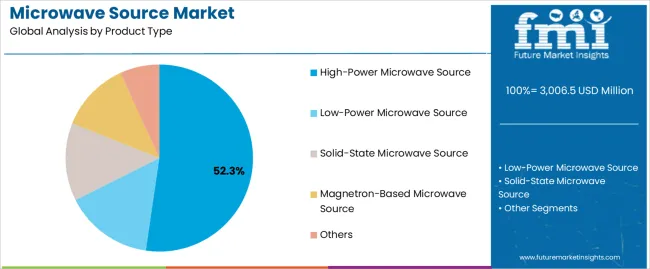
The high-power microwave source segment is projected to account for 52.3% of the microwave source market in 2025, reaffirming its position as the leading product category. Engineers and electromagnetic professionals increasingly utilize high-power microwave sources for their superior energy delivery characteristics, established reliability standards, and essential functionality in diverse applications across multiple project types. High-power microwave sources' proven performance characteristics and established cost-effectiveness directly address user requirements for reliable equipment operation and optimal electromagnetic precision in commercial applications.
This product segment forms the foundation of modern microwave system performance patterns, as it represents the component category with the greatest operational impact potential and established compatibility across multiple frequency ranges. Business investments in advanced power control technology and performance optimization continue to strengthen adoption among efficiency-conscious engineers. With users prioritizing energy consistency and equipment reliability, high-power microwave sources align with both productivity objectives and quality requirements, making them the central component of comprehensive electromagnetic strategies.
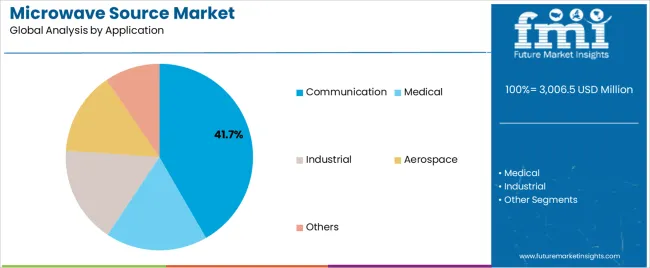
Communication is projected to represent 41.7% of the microwave source market in 2025, underscoring its critical role as the primary application for performance-focused engineers seeking superior signal processing benefits and enhanced system performance credentials. Telecommunications professionals and network engineers prefer communication applications for their established infrastructure requirements, proven market demand, and ability to maintain exceptional signal quality while supporting versatile frequency requirements during diverse communication projects. Positioned as essential applications for performance-conscious engineers, communication offerings provide both operational excellence and competitive positioning advantages.
The segment is supported by continuous improvement in signal processing technology and the widespread availability of established network standards that enable quality assurance and premium positioning at the telecommunications level. Additionally, communication companies are optimizing microwave source selections to support network differentiation and competitive performance strategies. As electromagnetic technology continues to advance and engineers seek efficient signal processing methods, communication applications will continue to drive market growth while supporting business development and customer satisfaction strategies.
The microwave source market is advancing rapidly due to increasing electromagnetic efficiency consciousness and growing need for precision frequency solutions that emphasize superior performance outcomes across communication segments and industrial applications. However, the microwave source market faces challenges, including competition from alternative electromagnetic technologies, equipment maintenance complexities, and component cost pressures affecting operational economics. Innovation in smart frequency monitoring integration and advanced materials continues to influence market development and expansion patterns.
The growing adoption of microwave sources in telecommunications projects and infrastructure development is enabling engineers to develop signal processing strategies that provide distinctive efficiency benefits while commanding competitive positioning and enhanced network performance characteristics. Communication applications provide superior frequency consistency while allowing more sophisticated signal control features across various network categories. Users are increasingly recognizing the operational advantages of microwave positioning for premium electromagnetic outcomes and efficiency-conscious system integration.
Modern microwave source manufacturers are incorporating advanced monitoring technologies, digital frequency control systems, and automated performance tracking to enhance operational precision, improve equipment longevity, and meet commercial demands for intelligent electromagnetic solutions. These systems improve operational effectiveness while enabling new applications, including predictive maintenance programs and performance optimization protocols. Advanced monitoring integration also allows engineers to support productivity leadership positioning and quality assurance beyond traditional electromagnetic operations.
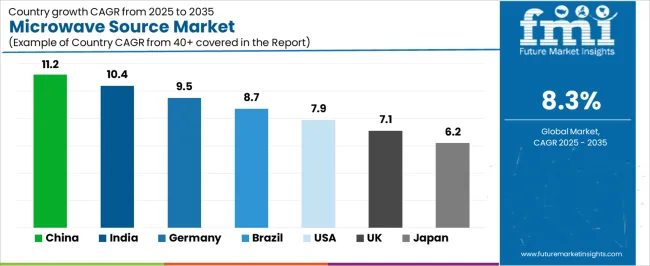
| Country | CAGR (2025-2035) |
|---|---|
| China | 11.2% |
| India | 10.4% |
| Germany | 9.5% |
| Brazil | 8.7% |
| USA | 7.9% |
| UK | 7.1% |
| Japan | 6.2% |
The microwave source market is experiencing robust growth globally, with China leading at an 11.2% CAGR through 2035, driven by the expanding telecommunications industry, growing medical equipment requirements, and increasing adoption of automated heating systems. India follows at 10.4%, supported by rising infrastructure development, expanding manufacturing sector, and growing acceptance of efficient electromagnetic solutions. Germany shows growth at 9.5%, emphasizing established engineering capabilities and comprehensive microwave technology development. Brazil records 8.7%, focusing on communication expansion and industrial heating growth. The USA demonstrates 7.9% growth, prioritizing advanced electromagnetic technologies and equipment optimization.
The report covers an in-depth analysis of 40+ countries; seven top-performing countries are highlighted below.
Revenue from microwave source consumption and sales in China is projected to exhibit exceptional growth with a CAGR of 11.2% through 2035, driven by the country's rapidly expanding telecommunications sector, favorable government policies toward infrastructure development, and initiatives promoting advanced electromagnetic technologies across major industrial regions. China's position as a leading manufacturing hub and increasing focus on automated heating systems are creating substantial demand for high-quality microwave sources in both domestic and export markets. Major telecommunications companies and equipment contractors are establishing comprehensive microwave capabilities to serve growing demand and emerging market opportunities.
Revenue from microwave source products in India is expanding at a CAGR of 10.4%, supported by rising infrastructure investment, growing industrial development, and expanding telecommunications capabilities. The country's developing manufacturing sector and increasing commercial investment in advanced electromagnetic technologies are driving demand for microwave sources across both traditional and modern communication applications. International equipment companies and domestic distributors are establishing comprehensive operational networks to address growing market demand for quality microwave systems and efficient electromagnetic solutions.
Revenue from microwave source products in Germany is projected to grow at a CAGR of 9.5% through 2035, supported by the country's mature manufacturing sector, established electromagnetic standards, and leadership in equipment technology. Germany's sophisticated industrial infrastructure and strong support for advanced microwave systems are creating steady demand for both traditional and innovative electromagnetic varieties. Leading equipment manufacturers and specialty distributors are establishing comprehensive operational strategies to serve both domestic markets and growing export opportunities.
Revenue from microwave source products in Brazil is projected to grow at a CAGR of 8.7% through 2035, driven by the country's emphasis on telecommunications expansion, industrial development, and growing electromagnetic contractor capabilities. Brazilian engineers and telecommunications companies consistently seek commercial-grade microwave sources that enhance system efficiency and support operational excellence for both traditional and modern electromagnetic applications. The country's position as a Latin American telecommunications leader continues to drive innovation in specialized microwave applications and commercial equipment standards.
Revenue from microwave source products in the USA is projected to grow at a CAGR of 7.9% through 2035, supported by the country's emphasis on electromagnetic technology advancement, equipment optimization, and advanced automation integration requiring efficient microwave solutions. American engineers and industrial users prioritize performance reliability and operational precision, making specialized microwave sources essential components for both traditional and modern electromagnetic applications. The country's comprehensive technology leadership and advancing electromagnetic patterns support continued market expansion.
Revenue from microwave source products in the UK is projected to grow at a CAGR of 7.1% through 2035, supported by established electromagnetic standards, mature contractor markets, and emphasis on equipment reliability across commercial and industrial sectors. British engineers and electromagnetic professionals prioritize quality performance and operational consistency, creating steady demand for premium microwave solutions. The country's comprehensive market maturity and established electromagnetic practices support continued development in specialized applications.
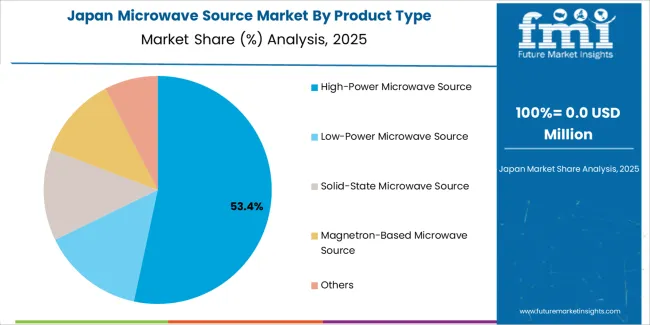
Revenue from microwave source products in Japan is projected to grow at a CAGR of 6.2% through 2035, supported by the country's emphasis on precision manufacturing, quality excellence, and advanced technology integration requiring efficient microwave solutions. Japanese businesses and industrial users prioritize technical performance and manufacturing precision, making specialized microwave sources essential components for both traditional and modern electromagnetic applications. The country's comprehensive quality leadership and advancing electromagnetic patterns support continued market expansion.
The Europe microwave source market is projected to grow from USD 687.2 million in 2025 to USD 1,453.8 million by 2035, recording a CAGR of 7.8% over the forecast period. Germany leads the region with a 38.4% share in 2025, moderating slightly to 37.9% by 2035, supported by its strong industrial base and demand for premium, technically advanced microwave equipment. The United Kingdom follows with 26.1% in 2025, easing to 25.7% by 2035, driven by a mature telecommunications market and emphasis on equipment reliability and performance optimization. France accounts for 14.8% in 2025, rising to 15.2% by 2035, reflecting steady adoption of automated electromagnetic solutions and operational efficiency enhancement. Italy holds 10.9% in 2025, expanding to 11.4% by 2035 as industrial heating and specialty electromagnetic applications grow. Spain contributes 5.2% in 2025, growing to 5.4% by 2035, supported by expanding telecommunications sector and equipment modernization. The Nordic countries rise from 3.1% in 2025 to 3.2% by 2035 on the back of strong technology adoption and advanced electromagnetic methodologies. BENELUX remains at 1.5% share across both 2025 and 2035, reflecting mature, efficiency-focused industrial markets.
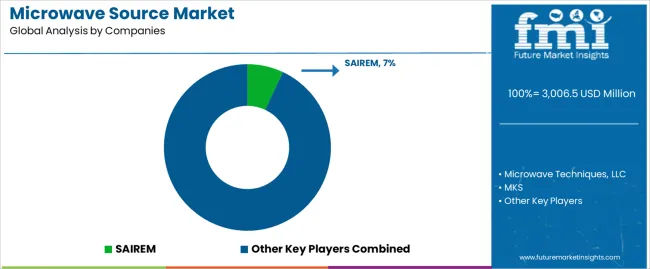
The microwave source market is characterized by competition among established equipment manufacturers, specialized component producers, and integrated electromagnetic solution companies. Companies are investing in precision manufacturing technologies, advanced material development systems, product innovation capabilities, and comprehensive distribution networks to deliver consistent, high-quality, and reliable microwave source systems. Innovation in power efficiency enhancement, frequency stability optimization, and application-specific product development is central to strengthening market position and customer satisfaction.
SaiREM leads the microwave source market with a strong focus on microwave equipment innovation and comprehensive electromagnetic solutions, offering commercial microwave systems with emphasis on manufacturing excellence and technological heritage. Microwave Techniques LLC provides specialized electromagnetic equipment with a focus on industrial market applications and performance engineering networks. MKS delivers integrated microwave solutions with a focus on semiconductor positioning and operational efficiency. AMTek specializes in comprehensive microwave equipment with an emphasis on precision applications. LEANFA focuses on comprehensive industrial microwave systems with advanced design and premium positioning capabilities.
The success of microwave sources in meeting commercial electromagnetic demands, engineer-driven efficiency requirements, and performance integration will not only enhance signal quality outcomes but also strengthen global equipment manufacturing capabilities. It will consolidate emerging regions' positions as hubs for efficient component production and align advanced economies with commercial electromagnetic systems. This calls for a concerted effort by all stakeholders -- governments, industry bodies, manufacturers, distributors, and investors. Each can be a crucial enabler in preparing the microwave source market for its next phase of growth.
How Governments Could Spur Local Production and Adoption?
How Industry Bodies Could Support Market Development?
How Distributors and Equipment Industry Players Could Strengthen the Ecosystem?
How Manufacturers Could Navigate the Shift?
| Items | Values |
|---|---|
| Quantitative Units (2025) | USD 3,006.5 million |
| Product Type | High-Power Microwave Source, Low-Power Microwave Source, Solid-State Microwave Source, Magnetron-Based Microwave Source, Others |
| Application | Communication, Medical, Industrial, Aerospace, Others |
| Power Level | Low-Power (below 1kW), Medium-Power (1kW-10kW), High-Power (10kW-100kW), Ultra-High-Power (above 100kW) |
| Frequency Range | L-band, S-band, C-band, X-band, Ku-band, Ka-band |
| Regions Covered | North America, Europe, Asia Pacific, Latin America, Middle East & Africa, Other Regions |
| Countries Covered | China, India, Germany, Brazil, United States, United Kingdom, Japan, and 40+ countries |
| Key Companies Profiled | SaiREM, Microwave Techniques LLC, MKS, AMTek, LEANFA, and other leading microwave source companies |
| Additional Attributes | Dollar sales by product type, application, power level, frequency range, and region; regional demand trends, competitive landscape, technological advancements in component engineering, precision manufacturing initiatives, power efficiency enhancement programs, and premium product development strategies |
The global microwave source market is estimated to be valued at USD 3,006.5 million in 2025.
The market size for the microwave source market is projected to reach USD 6,673.3 million by 2035.
The microwave source market is expected to grow at a 8.3% CAGR between 2025 and 2035.
The key product types in microwave source market are high-power microwave source, low-power microwave source, solid-state microwave source, magnetron-based microwave source and others.
In terms of application, communication segment to command 41.7% share in the microwave source market in 2025.






Full Research Suite comprises of:
Market outlook & trends analysis
Interviews & case studies
Strategic recommendations
Vendor profiles & capabilities analysis
5-year forecasts
8 regions and 60+ country-level data splits
Market segment data splits
12 months of continuous data updates
DELIVERED AS:
PDF EXCEL ONLINE
High-Power Microwave Source Market Size and Share Forecast Outlook 2025 to 2035
Microwave Monolithic Integrated Circuits Market Size and Share Forecast Outlook 2025 to 2035
Microwave Cable Assemblies Market Size and Share Forecast Outlook 2025 to 2035
Microwave Oven Market Size and Share Forecast Outlook 2025 to 2035
Microwaveable Stuffed Animal Toys Market Size and Share Forecast Outlook 2025 to 2035
Microwave Ablation Devices Market Size and Share Forecast Outlook 2025 to 2035
Microwave Market Size and Share Forecast Outlook 2025 to 2035
Microwave Backhaul System Market Size and Share Forecast Outlook 2025 to 2035
Microwave Device Market Size and Share Forecast Outlook 2025 to 2035
Microwave-Safe Utensils Market Size and Share Forecast Outlook 2025 to 2035
Microwave Absorbing Material Market Size, Growth, and Forecast 2025 to 2035
Microwave Power Meter Market
Microwave Antenna Market
Commercial Microwave Ovens Market Analysis – Size, Share, and Forecast 2025 to 2035
Commercial Microwaves Market
Point-to-point Microwave Antenna Market Analysis by Polarization, Antenna Type, Diameter, Frequency Range and Region Through 2035
WiMAX (Worldwide Interoperability For Microwave Access) Market Size and Share Forecast Outlook 2025 to 2035
Outsourced Testing Services Market Insights – Trends & Forecast 2025 to 2035
Air Source Heat Pump Market Size and Share Forecast Outlook 2025 to 2035
Crowdsourced Security Market Size and Share Forecast Outlook 2025 to 2035

Thank you!
You will receive an email from our Business Development Manager. Please be sure to check your SPAM/JUNK folder too.
Chat With
MaRIA